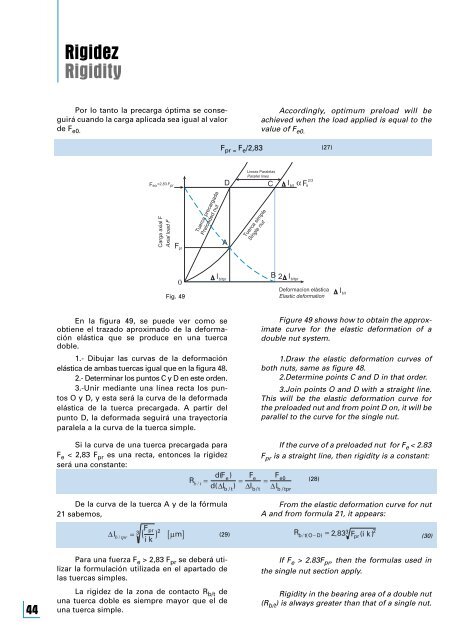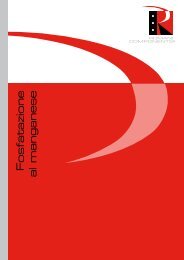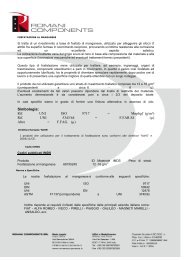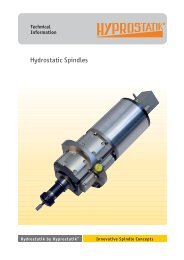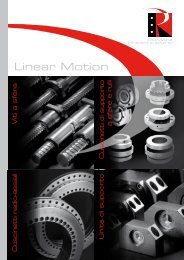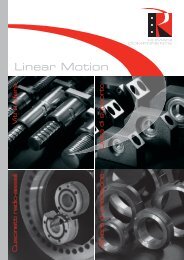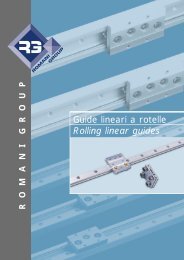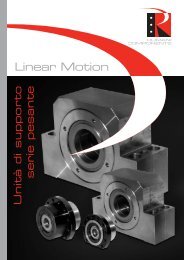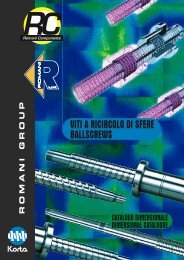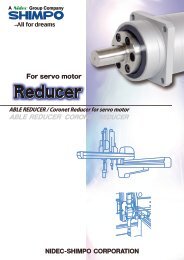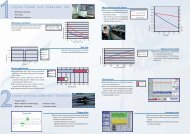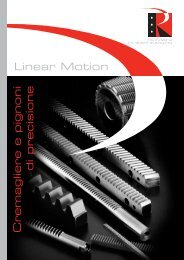catalogo tecnico technical catalogue - Romani Components
catalogo tecnico technical catalogue - Romani Components
catalogo tecnico technical catalogue - Romani Components
You also want an ePaper? Increase the reach of your titles
YUMPU automatically turns print PDFs into web optimized ePapers that Google loves.
Rigidez<br />
Rigidity<br />
Por lo tanto la precarga óptima se conseguirá<br />
cuando la carga aplicada sea igual al valor<br />
de F e0.<br />
Accordingly, optimum preload will be<br />
achieved when the load applied is equal to the<br />
value of F e0.<br />
F pr = F e /2,83<br />
(27)<br />
=2,83.F pr F eo<br />
Lineas Paralelas<br />
Parallel lines<br />
D C α F 2/3<br />
l b/t<br />
e<br />
Carga axial F<br />
Axial load F<br />
F pr<br />
Tuerca precargada<br />
Preloaded nut<br />
A<br />
Tuerca simple<br />
Single nut<br />
0<br />
Fig. 49<br />
l b/tpr<br />
B 2<br />
l b/tpr<br />
Deformacíon elástica<br />
Elastic deformation<br />
l b/t<br />
En la figura 49, se puede ver como se<br />
obtiene el trazado aproximado de la deformación<br />
elástica que se produce en una tuerca<br />
doble.<br />
1.- Dibujar las curvas de la deformación<br />
elástica de ambas tuercas igual que en la figura 48.<br />
2.- Determinar los puntos C y D en este orden.<br />
3.-Unir mediante una línea recta los puntos<br />
O y D, y esta será la curva de la deformada<br />
elástica de la tuerca precargada. A partir del<br />
punto D, la deformada seguirá una trayectoría<br />
paralela a la curva de la tuerca simple.<br />
Figure 49 shows how to obtain the approximate<br />
curve for the elastic deformation of a<br />
double nut system.<br />
1.Draw the elastic deformation curves of<br />
both nuts, same as figure 48.<br />
2.Determine points C and D in that order.<br />
3.Join points O and D with a straight line.<br />
This will be the elastic deformation curve for<br />
the preloaded nut and from point D on, it will be<br />
parallel to the curve for the single nut.<br />
Si la curva de una tuerca precargada para<br />
F e < 2,83 F pr es una recta, entonces la rigidez<br />
será una constante:<br />
R b / t = d(F e )<br />
d(∆l b / t<br />
) = F e<br />
=<br />
∆l b/ t<br />
If the curve of a preloaded nut for F e < 2.83<br />
F pr is a straight line, then rigidity is a constant:<br />
F e0<br />
∆l b / tpr<br />
(28)<br />
De la curva de la tuerca A y de la fórmula<br />
21 sabemos,<br />
From the elastic deformation curve for nut<br />
A and from formula 21, it appears:<br />
∆l b / tpr =<br />
( F 3<br />
pr<br />
) 2 [ µm] R b/ t(O− D) = 2,83 F pr (i k<br />
i k<br />
3<br />
(29) ) 2<br />
(30)<br />
44<br />
Para una fuerza F e > 2,83 F pr se deberá utilizar<br />
la formulación utilizada en el apartado de<br />
las tuercas simples.<br />
La rigidez de la zona de contacto R b/t de<br />
una tuerca doble es siempre mayor que el de<br />
una tuerca simple.<br />
If F e > 2.83F pr , then the formulas used in<br />
the single nut section apply.<br />
Rigidity in the bearing area of a double nut<br />
(R b/t ) is always greater than that of a single nut.


